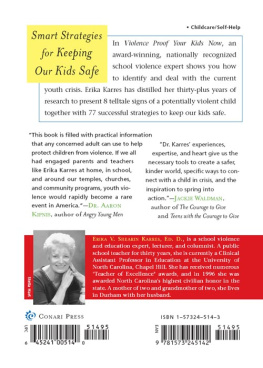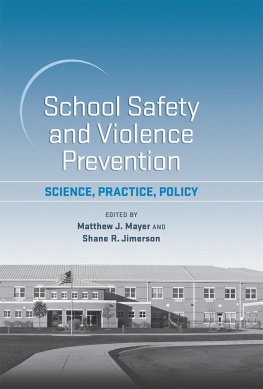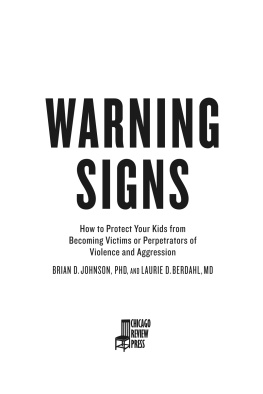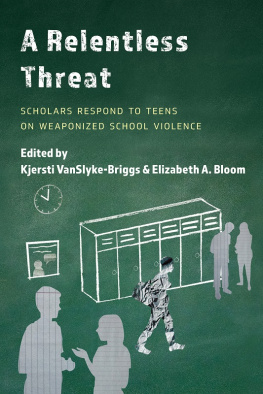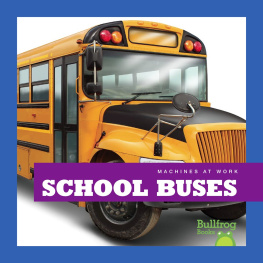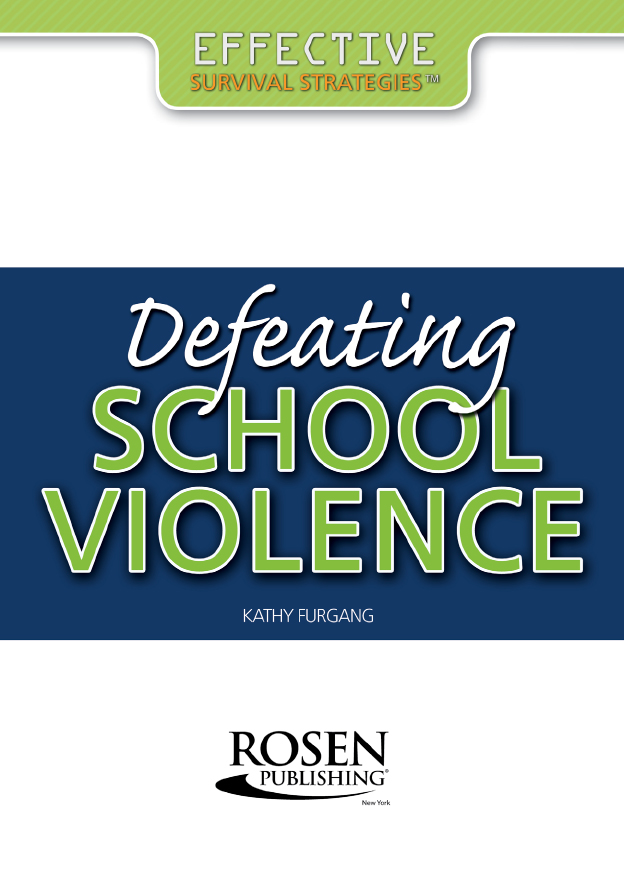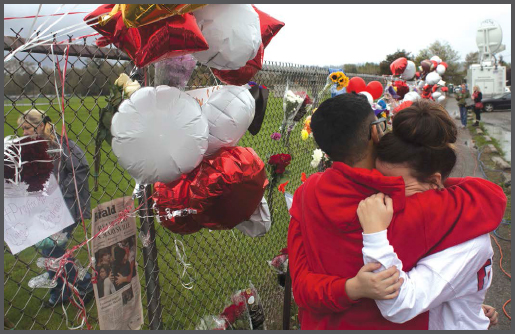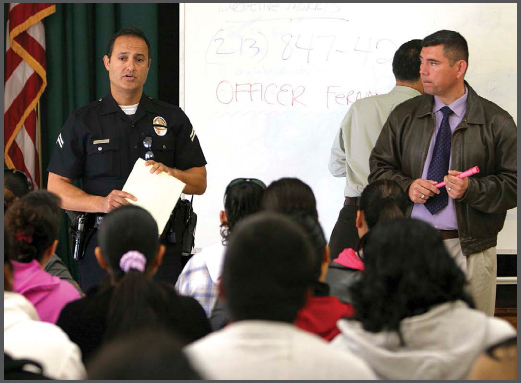Published in 2016 by The Rosen Publishing Group, Inc.
29 East 21st Street, New York, NY 10010
Copyright 2016 by The Rosen Publishing Group, Inc.
First Edition
All rights reserved. No part of this book may be reproduced in any form without permission in writing from the publisher, except by a reviewer.
Library of Congress Cataloging-in-Publication Data
Furgang, Kathy.
Defeating school violence / Kathy Furgang. First edition.
pages cm. (Effective survival strategies)
Includes bibliographical references and index.
ISBN 978-1-4994-6149-7 (library bound)
1. School violencePreventionJuvenile literature. I. Title.
LB3013.3.F85 2016
371.782--dc23
2015021639
For many of the images in this book, the people photographed are models. The depictions do not imply actual situations or events.
Manufactured in China
Contents
INTRODUCTION
CHAPTER 1
WHAT COUNTS AS SCHOOL VIOLENCE?
CHAPTER 2
BUT WHY?
CHAPTER 3
ADDRESSING THE PROBLEM
CHAPTER 4
WARNING SIGNS
CHAPTER 5
GETTING SUPPORT
CHAPTER 6
MAKING A DIFFERENCE FOR OTHERS
GLOSSARY
FOR MORE INFORMATION
FOR FURTHER READING
BIBLIOGRAPHY
INDEX
Introduction
I t seems that the nightly news is filled with example upon example of violence in schools all across North America. In October 2014, freshman Jaylen Fryberg opened fire on five people in his school cafeteria at Marysville-Pilchuck High School in Marysville, Washington. He then turned the gun on himself and died of a self-inflicted gunshot wound. One victim died at the scene, while three more later died of their wounds in the hospital.
School violence is not limited only to high schools. School shootings have occurred in schools where students as young as six years old have been affected. On December 14, 2012, the world stood in horror as news spread about a shooting at Sandy Hook Elementary School in Newtown, Connecticut. The twenty-year-old gunman, Adam Lanza, killed twenty children who were just six and seven years old, along with six adults, before turning the gun on himself. A total of twenty-eight people were killed.
Shootings or instances that end in death are not the only types of school violence. Bullying and fights in hallways, in school-yards, or on buses are also examples of violence that have made our schools unsafe. Gang violence in middle schools and high schools contributes to the problem. Some violence starts online. Electronic aggression in the form of cyberbullying and threats can make its way into schools, where the problem is escalated into face-to-face aggression and violence.
Community members grieve by a memorial for the victims of a high school shooting in Marysville, Washington, in October 2014. This is just one of the many tragic examples of school violence.
What drives people to violence against classmates and themselves? Are these senseless killings and attacks just part of the new normal in schools? Sadly, school violence is not a new phenomenon. Recorded instances of student-initiated school violence date back to the 1800s. The facts show that inner city schools may have more incidences of violence, but no school or town is immune to the problem. There can be violence and even death at schools in urban, suburban, and rural areas alike.
So what can people do to stop the violence? Are there ways to make schools a safe place for everyone? Some schools have implemented metal detectors to check that students have no weapons on them when they enter the school, but do such actions really make people less violent?
As we continue to look for answers to these questions, it is important to remember that even though school violence can lead to devastating consequences, it does not mean nothing can be done to help victims or prevent future occurrences. There are many resources and tools available to help both survivors and perpetrators of school violence move forward with their lives. Many victims of violence have gone on to assist others who have faced similar situations. There are also individuals working on tackling the issue at its roots in order to prevent school violence altogether. Although there are no easy answers, understanding the problem and why it occurs in the first place is an important step toward making schools safe for everyone.
CHAPTER 1
WHAT COUNTS AS SCHOOL VIOLENCE?
V iolent events are considered school violence when they occur on school property, on the way to or from school, during school-sponsored events, or on the way to or from school-sponsored events and are perpetrated by students against other students or faculty. School violence can also occur electronically. According to the Centers for Disease Control and Prevention (CDC), although less than 1 percent of youth homicides occur on a school campus, approximately 749,200 students between the ages of twelve and eighteen were victims of nonfatal school violence in 2012 alone. In 2013, 6.9 percent of high school students reported being threatened or hurt with a weaponguns, knives, or clubsat school. Both males and females have been the victims of school violence as well as perpetrators.
While deaths from school violence are quite rare, the number of injuries is higher. Examples of physical injuries from knives, sexual assault, and nonfatal gunshot wounds include bruises, broken bones, head traumas, and cuts. Nonphysical injuries are another tragic consequence of violence. Exposure to school violence can result in an increase in alcohol and drug use or the onset of depression or other psychological problems. The deep roots of psychological damage that school violence can cause students is evidenced in the fact that students who have been bullied either in person or online are two to nine times more likely to consider suicide than students who have not experienced bullying.
Some groups are more vulnerable to bullying than others, including students with disabilities and LGBT students, but all students are at risk of becoming a victim of violence.
Police officers in Los Angeles, California, discuss with parents and community members the increasing problem of gang violence in their neighborhood. Gang violence can sometimes make its way onto school property.
School violence can take many forms. It might involve a weapon, or it might not. It might involve groups of students fighting other groups, a groupa gang or otherwiseattacking one student, one student attacking multiple students, or it may occur one-on-one. Even verbal exchanges and written messages can count as examples of aggression. Any instance in which a student experiences victimization as a result of unwanted physical contact or an exercise of power can count as an example of school violence.
Mass school shootings are some of the most extreme examples of school violence. These occurrences involve one or more students bringing firearms to school to attack fellow students, teachers, staff, and, in many cases, themselves. These tragic incidents have usually resulted in multiple casualties and often have long-lasting consequences on students, communities, and the nation as a whole. Although these incidents usually receive wide coverage, however, there are other types of school violence that are far more common on school campuses.







